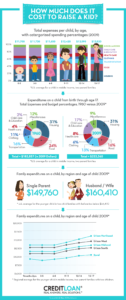It was over 10 years ago. Yet, I remember even the smell of the hospital sheets the day TFR Junior was born. I was in the hospital operating room after donning a protective gown when the doctors started to do a C-section on my wife. It was over in minutes and they handed the precious little thing into my waiting hands. At 8 ½ pounds and 21 inches, TFR Jr. wasn’t a tiny baby. Yet, he felt like the lightest thing I had held in my arms. I was so worried about accidentally dropping him that I lowered my arms in glacially slow motion onto the bed beside his mom. “First time dad, huh?” quipped the operating doctor.
TFR Jr. arrived not only into the loving family of TFR but also into this material world with over $30,000 in hard-working assets (invested in 100% equities). That put him right near the middle of American population’s net worth. Right on the day he was born! How did this happen? My wife and I started allocating a college fund for him even when we decided to have a baby because we were scared witless, thanks to media reports about how expensive it is to raise a child and future college costs.
There is a powerful infographic chart below from creditloan.com (click on the image to see the source) that summarizes why we all should be afraid….very afraid, of raising a child. It is a breakdown of the headline news from US Department of Agriculture (USDA) research that it costs $245,000, on average, to raise a child from birth till 18, and this doesn’t include college costs!
If you are a young adult reading this, remember this figure the next time you try to ‘slip one past the goal’. This chart is a powerful motivator for birth control, though USDA probably did not intend it that way.
Does a child really cost a fortune?
I am not covering pregnancy and delivery costs in detail because the figures vary with location and insurance coverage. I will give you a broad summary here. Since we went to a HMO-covered hospital, our entire hospitalization costs for delivering our baby worked to just $350. The multiple doctor visits during pregnancy and scans, would add another $1000, since they were only partly covered by insurance. Your mileage may vary.
An average family, USDA estimates, spends around $1000 a month, month-after-month, year-after-year, from birth till 17, as the chart shows. There is no respite at all. As you may expect, USDA says it costs a bit less to raise a child in rural America than in urban areas. It also costs more in urban upper north-east than in south. All understandable, because this is in line with cost of living in these areas. But even rural America is not ‘cheap’. If it costs between $9,000-$10,000 a year even in rural areas to raise a child in America, this can be a large financial burden for average families.
Using the broad numbers as a guideline, imagine spending $1000 a month raising your kid while earning $4000 (net of deductions/taxes), based on median U.S. household income. Even if your salary increases with inflation, so will these costs. By gobbling up 25% of your income for 17 years and beyond (for college), having a child becomes a scary prospect for many young couples.
If financial media already goes crazy about how sacrificing a $4 daily latte secures your retirement, what about having a child with these costs? Maybe that’s why the fertility rates have dropped to the lowest level ever in the U.S. Using the first year of child-raising costs as per the chart ($11,700) as a guide, the 4% rule would say, you need assets of nearly $300,000! And this doesn’t even include college.
Reality Check
While we haven’t done down-to-the-dollar budgeting of costs, we are fairly rigorous in tracking our spends (well within 10%). Right from the first day we brought our bundle of joy home until now (as a sprightly 10-year old discovering his strengths and interests), I can give you a picture of our real costs of raising a child. For comparison, I have used USDA age-wise data from the same chart.
In doing this analysis, I have ignored various gifts, freebies and outright discounts that TFR Jr. has enjoyed. We have certainly bought several toys and clothes over the years, but many toys were bought from Craigslist and clothes from Wal*Mart (they outgrow them well before the colors fade). Others bought our kid gifts too. Doting on the little guy is a privilege reserved not only for the parents but for extended family and friends as well.
In addition, I am ignoring the sizable monetary gifts from grandparents, which are in a separate fund on his name. His birthday cash gifts over the years are also in a separate fund. I am also ignoring some reduction in costs as a couple we have had to endure as a result of staying at home more often to care for the little guy. Foregoing one fine dinner pays for a month’s food supply for a baby, so the table includes the baby food costs but our savings from foregoing the fine restaurant meal aren’t in this table.
Also excluded are the child tax credit and the additional personal exemption that US federal tax law provides. So, Junior worked hard to save taxes for his dad even before he could say “dada”.
Only the direct full costs without any related reductions are included. So, you can safely say that the costs I have mentioned below over-states what we actually have spent so far in raising the kid.
Child's Age USDA Average/year TFR Actuals/year Reasons 0-2 $11,700 $7500 * High part-time daycare costs as we both were working during the first year
* Much lower second year onwards as Mrs. TFR quit her job
* Multiple doctor visits, new parents learning 3-5 $11,730 $4200 * Preschool plus home care not expensive if creative work-share with school is done 6-8 $11,650 $3600 * Same with elementary school, plus buying in discount stores
* TFR Junior health improves, less doctor visits 9-11 $12,420 $4000 * More board game toys, less electronic toys
* Friends and parents who think and spend similarly 12-14 $13,090 ?? Expect to be considerably lower than USDA Average based on past experience. 15-17 $13,370 ?? Expect to be considerably lower than USDA Average based on past experience.
So, there you have it. A way above average income family spending far below average in raising a child.
Adorable Square Roots
So, are we shortchanging our child? Is he going to grow up feeling deprived?
Well, let’s see. The little slugger is having an over-the-top luxurious childhood that his parents never had and importantly, not many of his peers even do. He gets to live in a large house, plays with friends and family, watches Pokemon to his heart’s content, has a closet full of clothes and toys (many of which we donate periodically after he outgrows them) and generally gets what he really wants (after convincing his dad). Above all, he has the love and affection of so many people in his family and enjoys the wonderful camaraderie of his growing friends network. He has an engaging smile and a funny bone that is hard to ignore. It makes even a bad day at work for Mr. TFR into something lot more tolerable. He is so excited about each day that we have trouble getting him to sleep on time.
From 10 years of first-hand experience, I can tell you raising a child need not cost a fortune. It doesn’t even have to cost anywhere near the scary ‘average’ that USDA estimates. Kids want your time and attention more than expensive gifts, lavish vacations, overpriced tutors and royal treatment summer camps. If you treat your child as just another member of your family (and not as a pampered prince/princess), and share the things and experiences that you anyway do with your family, a kid will not break your bank.
In fact, a different math applies here (see table below). The square root (SQRT) principle moderates cost increases with increasing family size – it holds good in our case and for the families that we know.
Family Size Expense Index Percent Increase over Baseline Why? 1 SQRT(1) = 1.00 -- Baseline case. Multiply your monthly expense by the expense index to estimate total expense for family size 2 SQRT(2) = 1.41 41% more than Single Marriage (or Couple) Benefit. Economies of scale from sharing housing, food and other costs, 3 SQRT(3) = 1.73 23% more than Couple.
73% more than Single All the benefits of sharing accrue, only incremental costs for the kid. 4 SQRT(4) =2.00 Only 16% more than 3-person family.
42% more than Couple Family size doubled but cost over couple went up only 42%. More economies of scale with second child than with just one child
Raman Venkatesh is the founder of Ten Factorial Rocks. Raman is a ‘Gen X’ corporate executive in his mid 40’s. In addition to having a Ph.D. in engineering, he has worked in almost all continents of the world. Ten Factorial Rocks (TFR) was created to chronicle his journey towards retirement while sharing his views on the absurdities and pitfalls along the way. The name was taken from the mathematical function 10! (ten factorial) which is equal to 10 x 9 x 8 x 7 x 6 x 5 x 4 x 3 x 2 x 1 = 3,628,800.




8 comments on “Raise a Child, Not a Fortune”